Social Care Services, Scotland, 2015
Latest national figures for Social Care services provided or purchased by Local Authorities in Scotland.
This document is part of a collection
2. Social Care Summary Information
Age and gender
Figure 4 shows that most social care clients tend to be in older age groups, and that the proportion of clients who are female increases with age; for the youngest age groups there is a slight majority who are male, however as the age groups get older there is an increasing proportion of females. The 18-64 age group (covered in Section 4 of this report) is split almost exactly 50/50 between male and female. For clients aged 65+ (covered in Section 3 of this report) 67% are female and 33% are male.
Factors that affect this include women on average living longer than men and women being more likely to live alone as they get older. Figure 4 also shows that the 0-17 age group accounts for less than 2% of clients. Due to potential disclosure issues with small numbers there is no section focusing on 0-17 year olds in this report.
Figure 4: Age and gender of Social Care clients, 2015
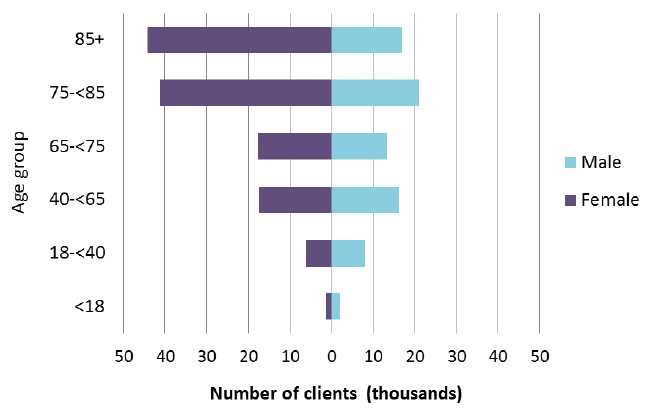
Note: Total of 205,430 clients. Gender information was unavailable for 40 clients.
Source: Scottish Government Social Care Survey 2015
Ethnicity
Of all 2015 Social Care clients for whom ethnicity information was known, 99% were recorded as being "White", with 1% in other ethnic groups (Table 1).
Table 1: Ethnicity of Social Care clients, 2015
| Ethnic Group | Clients* | Percentage** |
|---|---|---|
| White | 144,000 | 99% |
| Other ethnicity | 1,680 | 1% |
* Ethnicity information was unavailable for 59,740 clients.
** Percentages are based on client figures rounded to the nearest ten and are given to nearest percentage point.
Source: Scottish Government Social Care Survey 2015
Living arrangements (Home Care clients aged 18+)
Home Care clients are more likely to be living alone as they get older: 62% of those aged 65+ were living alone, compared with 47% of those aged 18-64 (Figure 5)
Figure 5: Living arrangements of Home Care clients aged 18+*, 2015
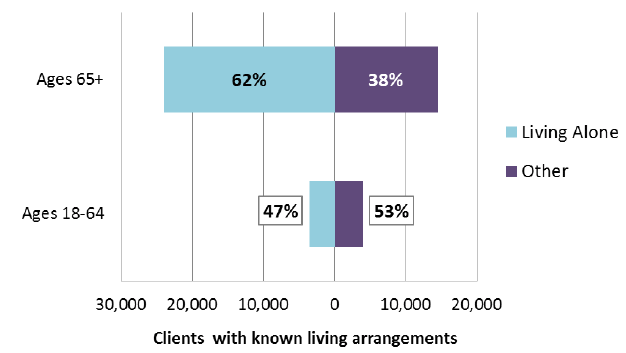
Based on 46,280 Home Care clients aged 18+. There were 15,220 cases with no data on Living Arrangements.
Source: Scottish Government Social Care Survey 2015
Client Group
Figure 6 shows the breakdown of Social Care clients by client group: the reason for needing a social care service. This shows that the largest groups are "Frail Older People" and "Physical Disability".
Figure 6: Client Group of clients receiving Social Care services, 2015
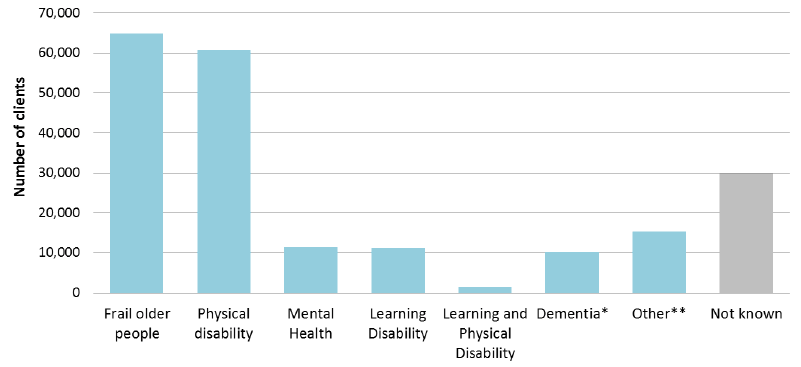
- Total of 205,430 clients
* Dementia is known to be under recorded in the social care management information system.
** "Other" includes addictions, palliative care and carers.
Source: Scottish Government Social Care Survey 2015
Figure 7 shows the breakdown of 2015 Social Care clients by age and client group. Almost all of the clients receiving a service due to being frail and elderly (99%) or due to dementia (98%) are aged 65 and over, while the majority of those receiving a service due to Mental Health or a Learning Disability are aged under 65.
Figure 7: Proportion of Social Care clients aged (a) under 65 and (b) 65+, by client group, 2015
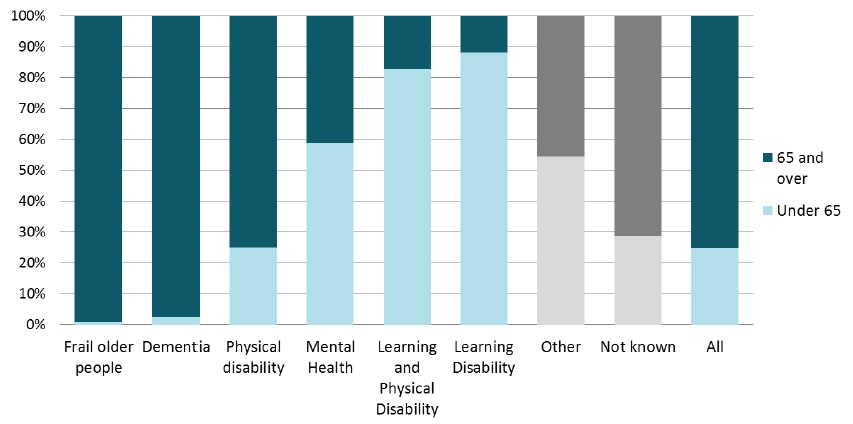
Source: Scottish Government Social Care Survey 2015
Home Care service provision
Over the past ten years Local Authorities have increasingly purchased Home Care from the private and voluntary sector, rather than providing services directly themselves. In March 2015, 48% of clients were receiving services provided solely by Local Authority staff (Figure 8). This proportion has been decreasing each year since 2007, and this is the first year that the figure has fallen below 50%. The proportion of Home Care hours being provided by Local Authority staff was 33% in March 2015 and has again decreased every year since 2007. The difference between these proportions and those seen for client numbers reflects the fact that the private and voluntary sectors, on average, provide larger packages of care.
Figure 8: Home Care provision by Service Provider, 2007 to 2015 (all ages)
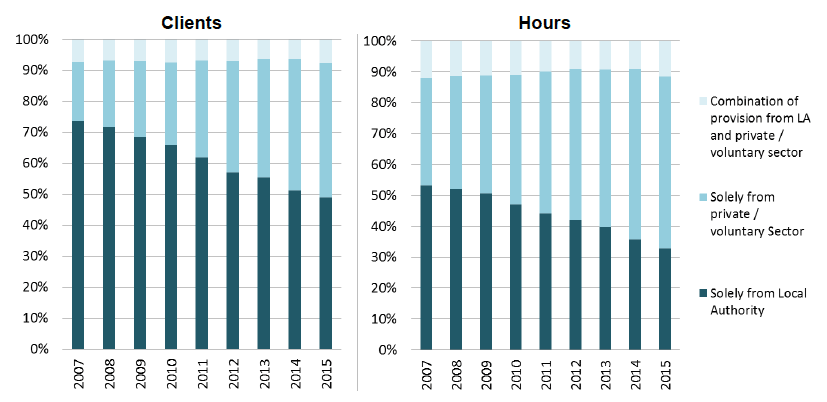
Source: Scottish Government Social Care Survey 2013-2015, Home Care Census 2007-2012
Age breakdown for key services covered in this report
Sections 3 and 4 of this report focus on older people (ages 65+) and working-age adults (ages 18-64) respectively. The services covered in these sections are Home Care, Community Alarm / Telecare and Direct Payments: Figure 9 shows the age distribution of clients receiving these three services: while Community Alarm / Telecare and Home Care services are mainly used by older people, the majority of people receiving Direct Payments are aged under 65.
Figure 9: Home Care, Community Alarm/Telecare and Direct Payments clients, by age, 2015
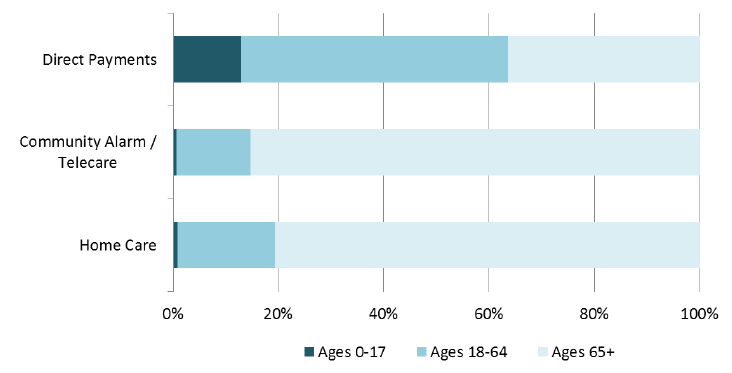
Source: Scottish Government Social Care Survey 2015
Local Authority comparison: Home Care & Direct Payments rates per 1,000 population
Figures 10 and 11 give an overview of how service provision varies across Scotland for Home Care and Direct Payments respectively. The number of clients receiving Home Care / Direct Payments for each Local Authority is presented as a rate per 1,000 population.
Note that while these charts enable comparisons to be made between Local Authorities, they should not be considered as a "ranking". There are several factors that can affect levels of recorded service provision, such as differing proportions of elderly people (who make greater use of Home Care) and different levels of deprivation. Such variations are reflected in the funding formulae used to allocate resources to Local Authorities.
Figure 10: Clients receiving Home Care per 1,000 population, by Local Authority, 2015
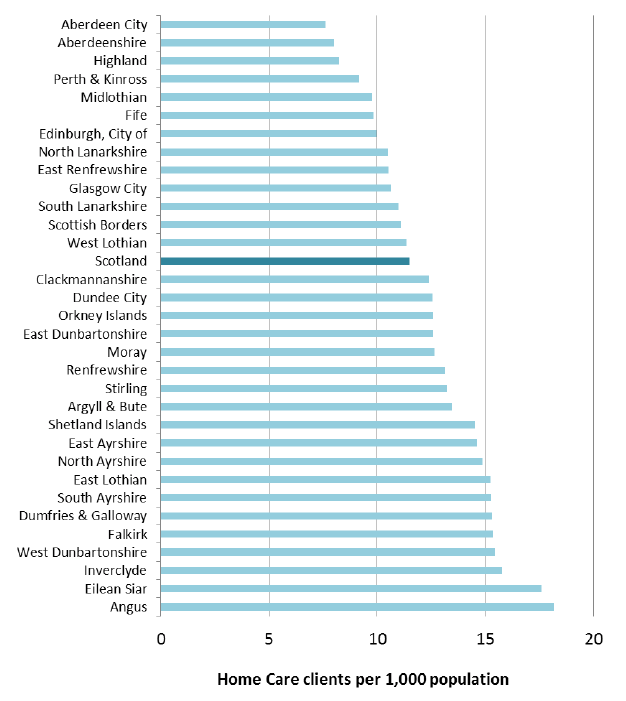
Source: Scottish Government Social Care Survey 2015
Figure 11: Clients receiving Direct Payments per 1,000 population, by Local Authority, 2015
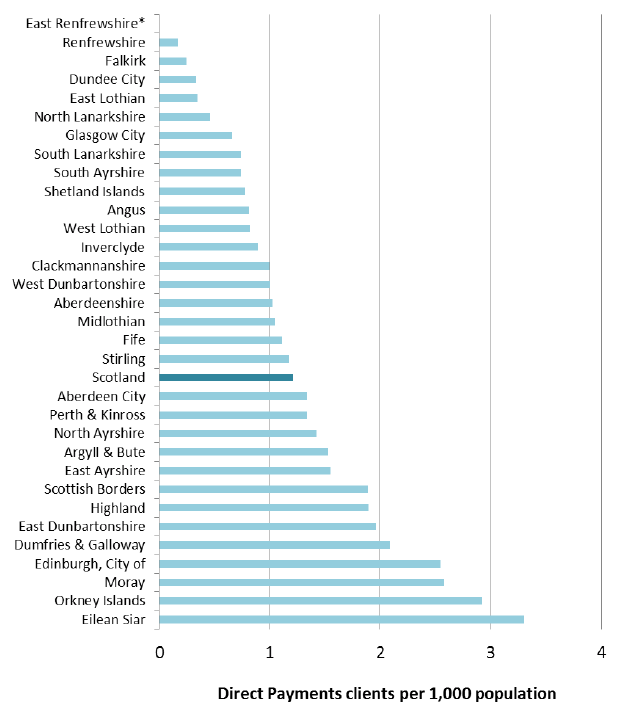
* No 2015 data on Direct Payments was available from East Renfrewshire council - see 5.5 (background notes).
Source: Scottish Government Social Care Survey 2015
Meals Services
Data on Meals services provided at home has proved difficult for Local Authorities to capture, and as such the figures presented here; i) are likely to be less than the true figures, and ii) should not be compared with previous years' figures to gauge changes in provision. There were 7,640 people recorded as receiving Meals services at the 2015 census. Figure 12 shows that most clients who received meals services were in the older age groups, while the majority (55%) received hot meals rather than frozen meals.
Figure 12: Clients aged 65+ receiving Hot or Frozen Meals*, by age, 2015
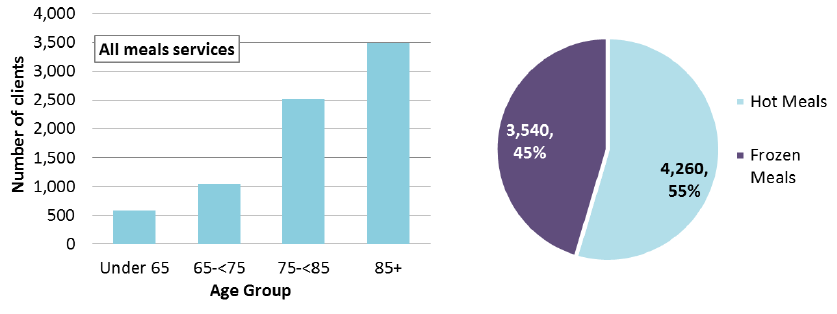
* Some clients receive both hot and frozen meals.
* Four Local Authorities did not submit Meals data for 2015. Direct comparisons should not be made with previous years.
Source: Scottish Government Social Care Survey 2015
Housing Support
Data on Housing Support is presented for the first time in 2015. Housing Support includes services such as assistance to claim welfare benefits, filling in forms, managing budgets and help with shopping and housework. In previous years there has been some overlap in the definitions of Housing Support and Home Care used in recording by some Local Authorities; from 2013 Local Authorities were asked to record Live-in and 24/7 services as Housing Support and not Home Care. Note that around 80% of Housing Support clients were recorded as also receiving another Social Care service, while for 10 Local Authorities this figure was 100%. This suggests there are likely to be other Housing Support clients who are not captured in the survey.
There were 18,030 people recorded as receiving Housing Support in 2015. This is just under a third of the number who receive Home Care (61,500). While Home Care is provided mainly for older people, Housing Support tends to be split more evenly between older people and under 65s (Figure 13). Note that there is some overlap between the two categories: around one third of Housing Support clients (32%) also received Home Care.
Figure 13: Number of clients receiving Housing Support* and Home Care, by age, 2015
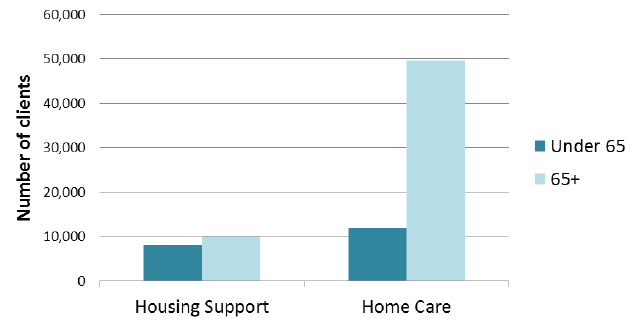
*Around one third of Housing Support clients (32%) also received Home Care.
*80% of Housing Support clients were recorded as also receiving another Social Care service, while for 10 Local Authorities this figure was 100%. This suggests there may be extra Housing Support clients not captured in the survey.
Source: Scottish Government Social Care Survey 2015
The remainder of this report looks in more detail at the provision of Home Care, Community Alarm / Telecare services and Direct Payments for older people (Section 3) and working age adults (Section 4).
Contact
Email: Steven Gillespie
There is a problem
Thanks for your feedback